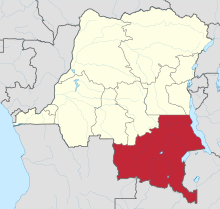
Back حرب شابا الأولى Arabic Primer guerra de Shaba AST Primera guerra de Shaba Spanish Première guerre du Shaba French Prima guerra dello Shaba Italian Primeira Guerra de Shaba Portuguese Мятеж в провинции Шаба (1977) Russian
| Shaba I | |||||||
|---|---|---|---|---|---|---|---|
| Part of the Shaba Invasions and the Cold War | |||||||
 Zairian troops with a beret-wearing Moroccan military advisor | |||||||
| |||||||
| Belligerents | |||||||
|
Supported by: |
Supported by: | ||||||
| Commanders and leaders | |||||||
|
|
| ||||||
| Strength | |||||||
|
Zaire: 3,000–4,000[11] Morocco: 1,300[1]–1,500 paratroopers Egypt: 50 Pilots and Technicians[12] France: 20–65 soldiers[1] Belgium: 80 soldiers[1] | 1,600–3,000 FNLC fighters | ||||||
| Casualties and losses | |||||||
|
Morocco: 8 killed[7] | ~100+ killed | ||||||

Shaba I was a conflict in Zaire's Shaba (Katanga) Province lasting from 8 March to 26 May 1977. The conflict began when the Front for the National Liberation of the Congo (FNLC), a group of about 2,000 Katangan Congolese soldiers who were veterans of the Congo Crisis, the Angolan War of Independence, and the Angolan Civil War, crossed the border into Shaba from Angola. The FNLC made quick progress through the region because of the sympathizing locals and the disorganization of the Zairian military (Forces Armées Zaïroises, or FAZ). Travelling east from Zaire's border with Angola, the rebels reached Mutshatsha, a small town near the key mining town of Kolwezi.
Zairian President Mobutu Sese Seko accused Angola, East Germany,[6] Cuba and the Soviet Union of sponsoring the rebels. Motivated by anticommunism and by economic interests, both the Western Bloc and China sent assistance to support the Mobutu regime. The most significant intervention, orchestrated by the Safari Club, featured a French airlift of Moroccan troops into the war zone. The intervention turned the tide of the conflict.[13] US President Jimmy Carter approved the shipment of supplies to Zaire but refused to send weapons or troops and maintained that there was no evidence of Cuban involvement.
The FAZ terrorized the population of the province during and after the war. Bombing and other acts of violence led 50,000 to 70,000 refugees to flee into Angola and Zambia. Journalists were prevented from entering the province, and several were arrested. However, Mobutu won a public relations victory and ensured continuing economic assistance from governments, the International Monetary Fund, the World Bank and a group of private lenders led by Citibank.
The FAZ and outside powers clashed again with insurgents in a 1978 conflict, Shaba II.
- ^ a b c d Berman, Eric G.; Sams, Katie E. (2000). Peacekeeping In Africa : Capabilities And Culpabilities. Geneva: United Nations Institute for Disarmament Research. ISBN 978-92-9045-133-4. Berman and Sams cite the lower number.
- ^ a b A Little Help from His Friends Time, 04/25/1977, Vol. 109 Issue 17, p.57
- ^ Cite error: The named reference
Odom25was invoked but never defined (see the help page). - ^ "Nigeria to Move, At U.S. Request, In Zaire Dispute", Washington Post, 23 March 1977, p. A1; accessed via ProQuest.
- ^ "Nigeria Appeals on Arms", New York Times, 24 March 1977, p. A7; accessed via ProQuest.
- ^ a b Zaire Says East Germany Supplies Arms to Rebels - New York Times, May 1, 1977. Retrieved on April 8, 2017.
- ^ a b Le Sahara occidental, enjeu maghrébin,page 304
- ^ Driss Bennani. "Exclusif. Portrait-enquête. Laânigri. Un destin marocain (Son ascension, sa chute…)". Telquel. No. 239. Archived from the original on 22 February 2014. Retrieved 5 February 2014.
- ^ Cite error: The named reference
LAT17Aprilwas invoked but never defined (see the help page). - ^ Robin Wright, "Moroccan Army Chief Visits Area of Fighting in Zaire", Washington Post, 15 April 1977; accessed via ProQuest.
- ^ Katangan Gendarmes Archived 2013-10-04 at the Wayback Machine Leigh Ingram-Seal
- ^ Ogunbadejo, "Conflict in Africa" (1979), p. 227.
- ^ Chris Cook and John Stevenson. The Routledge Companion to World History Since 1914, 2005. Pages 321-322.